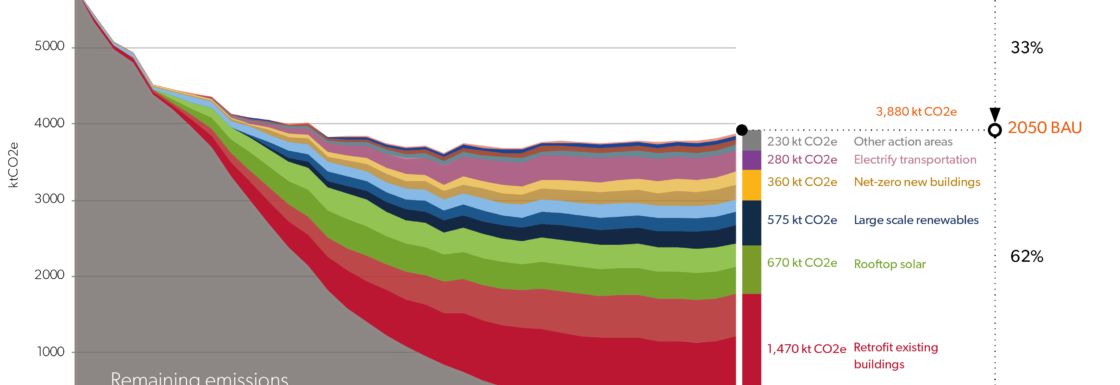HalifACT – A Coastal City’s Climate Plan – Voted Clean50 Top Project of-the-Year

Projects Sponsor
On January 29, 2019, Halifax Regional Council declared a climate emergency and began the work of creating an updated climate plan. Their ambitious plan, HalifACT––approved unanimously by Halifax Regional Council in June 2020––is a set of 46 actions designed to help the municipality meet a net-zero emissions goal by 2050.
Developed by Halifax’s Regional Municipality’s Environment and Climate Change team, HalifACT will save money, prevent loss, prepare communities, and improve wellbeing. Regional Council approved a dedicated 3% tax to fund HalifACT for a minimum of 10 years. That’s $18M a year to help HalifACT mainstream climate action across the organisation, with key partners and the public, allowing them to move faster and further, using a collective impact approach.
It’s a local act that needs to be taken global.

Wedge Diagram showing areas of Emission Reductions needed in Halifax
The story of HalifACT began with the city’s recognition that Halifax’s energy and climate change plans were outdated. Nothing in the city’s plans adequately addressed long-term energy conservation and greenhouse gas (GHG) emission reduction goals, something that needed to be done at both the corporate and community levels.
In the face of the climate crisis, Halifax Regional Municipality was determined to do this, and to future-proof Halifax’s operations––inspiring other cities to take similar, bold constructive action. The daunting task they set for themselves included developing community-wide climate and energy objectives for all sectors––buildings, transportation, waste/water, agriculture and forestry, energy, and others. This is key to sustainably transitioning Halifax to a low-carbon economy, alongside other large urban centres in Canada. Their goals also included advancing corporate and community climate change adaptation efforts that promote preparedness and long-term resiliency. As well, they hoped to lay a foundation upon which ongoing internal and external stakeholders could collaborate to build community resilience, enhance energy efficiency and achieve greenhouse gas reduction targets out to 2050.
The resulting Climate Action Plan, HalifACT: Acting on Climate Together (Halifax’s leading edge climate mitigation and adaptation plan), focuses on building resilience to current and future climate impacts. Aiming to help the city reduce community emissions by 75% by 2030 and reach net-zero by 2050, it was approved unanimously by Halifax Regional Council in June 2020; and understanding how Halifax got there, offers a roadmap for other municipalities.

Early on, an expert consulting group was engaged to do the baseline energy and emissions model in order to help determine what it would take to get to net-zero on time, while keeping within the city’s carbon budget. The team assembled an extensive group of stakeholders, casting the net broadly with a lens of equity, diversity, and inclusion. This outreach and inclusion resulted in four hundred people coming aboard, representing more than a hundred organisations. The group helped develop the HalifACT plan from start to finish. Public feedback on this was also solicited and overwhelmingly the message was that this work needs to be done, and to hurry it up already.
A detailed charter gave the project momentum and aided it in securing the necessary funds. Internal and—to ensure meaningful commitment and participation—external stakeholder teams with terms of reference were created. A communications strategy and engagement plan were developed. Three large in-person stakeholder meetings, with assistance from a consultant and a facilitator, were held over several months. All parties approved the target of net-zero by 2050 and assisted with ideas and information related to climate barriers, opportunities, and more.

HalifACT Stakeholder Network Working Group Table Picture
Putting forward a plan to council with targets that seem, but are not, impossible, was a delicate process. A lot of time was spent explaining, demonstrating, making the case for this type of approach, and trying to show that, when it comes to climate change, a business-as-usual mode is no longer on the (sinking) table. Not all stakeholders are aligned in how to achieve net-zero by 2050, so some competing interests and ethoses came into play. Finding, highlighting and continuing to meet and work on common ground was key to passing the plan and is the key to making it succeed.
Once they’d built the ambitious target rich plan and navigated it through the council, the process of mainstreaming the forty-six climate actions across departments and externally began. The team developed a shared accountability structure internally and offered support to assist teams in succeeding with their new responsibilities. The focus was on change management and developing a governance model for plan implementation. Training in collective impact for climate action was made available to staff and stakeholders. Support for community members and stakeholders in testing climate ideas to scale up and out, should they be successful, is ongoing. This is done through an Innovation Outpost, a joint effort run with the Halifax Partnership economic development agency.
The work, while very much on going, is already showing results. From the baseline year of 2016, corporate emissions decreased by 20.4% and community-wide emissions decreased by 7.4% post-plan-passing. Council has approved a new EV strategy and an administrative order requiring the city to build to net-zero.
Significantly, a dedicated 3% tax was created to fund HalifACT for a minimum of ten years. That’s $18M a year to help HalifACT mainstream climate action across the organisation, with key partners and the public, allowing them to move faster and further, using a collective impact approach.
The HalifACT plan is a local act that needs to be taken global.
















